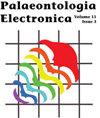Baltica志留纪珊瑚和层孔虫的共生
IF 1.5
4区 地球科学
Q1 Earth and Planetary Sciences
引用次数: 0
摘要
从乌克兰、摩尔多瓦、白俄罗斯和科米共和国(俄罗斯联邦)志留纪收集的大量叠孔虫和珊瑚的薄片显示,叠孔虫/珊瑚与其他无脊椎动物之间存在骨骼共生的现象。叠层孔虫与软体蠕虫(Helicosalpinx和Chaetosalpinx),钙质触手状管蠕虫(microconchids, Cornulites, conconcolites)和rugosans形成共生关系。表状珊瑚与珠状珊瑚形成共生关系。所研究的以层孔虫为基础的关联主要是由没有矿物骨骼的蠕虫的生物闭锁。很可能非矿化的无脊椎动物比有矿化骨骼的无脊椎动物从内源性生活模式中受益更多,因为后者已经有了自己的保护来抵御捕食者。每个寄主层孔虫种的共生体类群数量几乎没有差异,表明所有研究的层孔虫对不同内生物的耐受性相当相似。塔玛拉Borisenko。乌克兰地质调查局,基辅,乌克兰。tamaraborisenko2@gmail.com Olev Vinn。塔尔图大学生态与地球科学研究所,爱沙尼亚塔尔图50411olev.vinn@ut.ee Volodymyr Grytsenko乌克兰国家自然历史博物馆,基辅,乌克兰。favosites@ukr.net Ion Francovschi。布加勒斯特大学,罗马尼亚布加勒斯特地质与地球物理学院,摩尔多瓦共和国地质与地震学研究所Chișinău。frankovski.ww@gmail.com Yury Zaika。统一企业“地球服务”,莫拉53,220015,明斯克,白俄罗斯。yu_z@tut.by本文章由计算机程序翻译,如有差异,请以英文原文为准。
Symbiosis in corals and stromatoporoids from the Silurian of Baltica
The large collection of thin sections of stromatoporoids and corals from the Silurian of Ukraine, Moldova, Belarus, and Komi Republic (Russian Federation) revealed several incidences of skeletal intergrowth between stromatoporoids/ corals and the other invertebrates. The stromatoporoids formed symbiotic associations with soft-bodied worms (Helicosalpinx and Chaetosalpinx), calcareous tentaculitoid tubeworms (microconchids, Cornulites, Conchicolites), and rugosans. Tabulate corals formed symbiotic associations with cornulitids. The studied stromatoporoid based associations are dominated by bioclaustrations of worms without mineral skeletons. Most likely non-mineralized invertebrates benefitted more from endobiotic life mode than invertebrates with mineralized skeletons as the latter already had protection on their own against predators. There was almost no difference in the number of symbiont taxa per host stromatoporoid species indicating that all studied stromatoporoids were rather similar in their tolerance towards different endobionts. Tamara Borisenko. Geological Survey of Ukraine, Kyiv, Ukraine. tamaraborisenko2@gmail.com Olev Vinn. University of Tartu, Institute of Ecology and Earth Sciences, Ravila 14A, 50411 Tartu, Estonia. olev.vinn@ut.ee Volodymyr Grytsenko. National Natural History Museum NAS of Ukraine, Kyiv, Ukraine. favosites@ukr.net Ion Francovschi. University of Bucharest, Faculty of Geology and Geophysics, Bucharest, Romania, and Institute of Geology and Seismology, Chișinău, Republic of Moldova. frankovski.ww@gmail.com Yury Zaika. Unitary Enterprise “Geoservice”, Maura 53, 220015, Minsk, Belarus. yu_z@tut.by
求助全文
通过发布文献求助,成功后即可免费获取论文全文。
去求助
来源期刊

Palaeontologia Electronica
地学-古生物学
CiteScore
3.60
自引率
0.00%
发文量
20
审稿时长
>12 weeks
期刊介绍:
Founded in 1997, Palaeontologia Electronica (PE) is the longest running open-access, peer-reviewed electronic journal and covers all aspects of palaeontology. PE uses an external double-blind peer review system for all manuscripts. Copyright of scientific papers is held by one of the three sponsoring professional societies at the author''s choice. Reviews, commentaries, and other material is placed in the public domain. PE papers comply with regulations for taxonomic nomenclature established in the International Code of Zoological Nomenclature and the International Code of Nomenclature for Algae, Fungi, and Plants.
 求助内容:
求助内容: 应助结果提醒方式:
应助结果提醒方式:


